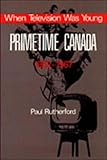When Television was Young : Primetime Canada, 1952-1967 / Paul Rutherford.
Material type: TextPublisher: Toronto : University of Toronto Press, [1992]Copyright date: ©1990Description: 1 online resource (637 p.)Content type:
TextPublisher: Toronto : University of Toronto Press, [1992]Copyright date: ©1990Description: 1 online resource (637 p.)Content type: - 9780802066473
- 9781442683334
- 791.45/0971
- PN1992.3.C3 R878 1990eb
- online - DeGruyter
| Item type | Current library | Call number | URL | Status | Notes | Barcode | |
|---|---|---|---|---|---|---|---|
 eBook
eBook
|
Biblioteca "Angelicum" Pont. Univ. S.Tommaso d'Aquino Nuvola online | online - DeGruyter (Browse shelf(Opens below)) | Online access | Not for loan (Accesso limitato) | Accesso per gli utenti autorizzati / Access for authorized users | (dgr)9781442683334 |
Browsing Biblioteca "Angelicum" Pont. Univ. S.Tommaso d'Aquino shelves, Shelving location: Nuvola online Close shelf browser (Hides shelf browser)

|

|

|

|

|

|

|
||
| online - DeGruyter What's Mother Got to do with it? : Protecting Children from Sexual Abuse / | online - DeGruyter When Canadian Literature Moved To New York / | online - DeGruyter When Freedom is Lost : The Dark Side of the Relationship Between Government and the Fort Hope Band / | online - DeGruyter When Television was Young : Primetime Canada, 1952-1967 / | online - DeGruyter White Civility : The Literary Project of English Canada / | online - DeGruyter White Man's Law : Native People in Nineteenth-Century Canadian Jurisprudence / | online - DeGruyter White Tie and Decorations : Sir John and Lady Hope Simpson in Newfoundland, 1934-1936 / |
restricted access online access with authorization star
http://purl.org/coar/access_right/c_16ec
A decade after the first Canadian telecasts in September 1952, TV had conquered the country. Why was the little screen so enthusiastically welcomed by Canadians? Was television in its early years more innovative, less commerical, and more Canadian than current than current offerings? In this study of what is often called the 'golden age' of television, Paul Rutherford has set out to dispel some cherished myths and to resurrect the memory of a noble experiment in the making of Canadian culture. He focuses on three key aspects of the story. The first is the development of the national service, including the critical acclaim won by Radio-Canada, the struggles of the CBC's English service to provide mass entertainment that could compete with the Hollywood product, and the effective challenge of private television to the whole dream of public broadcasting.The second deals with the wealth of made-in-Canada programming available to please and inform vviewers - even commercials receive close attention. Altogether, Rutherford argues, Canadian programming reflected as well as enhanced the prevailing values and assumptions of the mainstream.The final focus is on McLuhan's Question: What happens to society when a new medium of communications enters the picture? Rutherford's findings cast doubt upon the common presumptions about the awesome power of television.Television in Canada, Rutherford concludes, amounts to a failed revolution. It never realized the ambbitions of its masters or the fears of its critics. Its course was shaped not only by the will of the government, the power of commerce, and the empire of Hollywood, but also by the desires and habits of the viewers.
Mode of access: Internet via World Wide Web.
In English.
Description based on online resource; title from PDF title page (publisher's Web site, viewed 01. Nov 2023)


